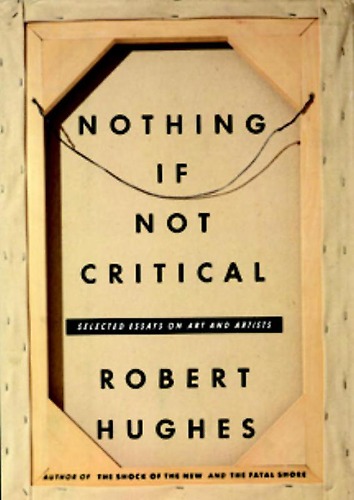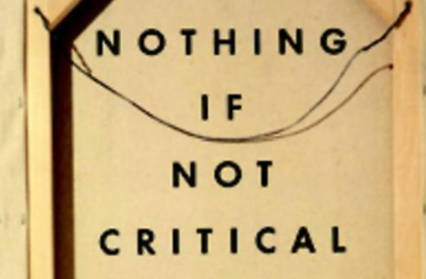Adam Somerset reviews Nothing if Not Critical, a collection of essays on art and artists by Australian artist and writer Robert Hughes.
Islington’s Estorick gallery held an exhibition this last winter of Giorgio Morandi. The critics, with Laura Cumming in the lead, did a good job, but none did better than a critic who had died in August 2012. Robert Hughes was at the Guggenheim’s Morandi show in 1981. The report for Time Magazine – covering Morandi’s historical context, technique, biography and aesthetics – reads undimmed in its freshness, breadth and completeness.
Criticism that lasts a year or so is not uncommon. Reviews that leap fresh from the page two decades on are to be treasured. The ninety-four reviews and essays, written during Robert Hughes’ tenure as New York art critic, cannot help but reveal their time. Topical references are, however, few and scattered. In the inconceivable era of pre-revolutionary Iran, Reza Pahlavi is a swaggering presence on the art scene. Warhol, even, is a favoured visitor at the Court of the Peacock Throne. ‘Seurat in the parlour,’ as Hughes sardonically puts it, ‘SAVAK in the basement.’
The big money that swirls around the 1980s auction rooms is different. Corporate Japan, and big flash money, are at their zenith. All those mineral monopolists from the Urals and eastwards are still loyal juniors in their communist fiefdoms. The mobile phone is a chunky piece of power-draining kit owned by a few. It has not yet given Mexico the world’s most expensive call rates and the mogul with the spare seventy million for a rare Klimt to hit the market. A critic cannot help but be of his time, but the judgements that run through Nothing if Not Critical are still strikingly apt.
Thirty years in the course of the old masters is little. In 1983, Hughes sees in Holbein that ‘nobody else got the knobbly, mild face of English patrician power so aptly, or so clearly the reserves of cunning and toughness veiled by the pink mask.’ ‘Knobbly’ appears again when he assesses the achievement of Van Dyck, pinpointing ‘the vanishing archetype of aristocracy, calm and straight as a Purdey gun barrel, with the look of arrogant security, guaranteed to paralyse all lesser breeds from Calais to Peshawar.’ It takes an Australian to see an old Britain in that light.
Hughes, always the journalist before the servant of academe, has no fear of the phrase of a colour to match the paint. Caravaggio, that most morally dubious among the great, ‘thrashed about in the etiquette of early seicento cultivation like a shark in a net.’ Lovis Corinth stands out for his ‘robust dash and splash.’ Degas is possessed of ‘that icy, precise objectivity which was one of the masks of his unrelenting power of aesthetic deliberation.’

by Robert Hughes
429pp, Collins Harvill 1990
Linguistic fearlessness pervades. Of his own calling, Hughes wrote elsewhere: ‘One gets tired of the role critics are supposed to have in this culture: it’s like being the piano player in a whorehouse; you don’t have any control over the action going on upstairs.’ With lines like this it is small surprise he is little persuaded by the hype that turns a select contemporary few into objects of high desire. Baselitz is ‘that sturdy fountain of overwrought mediocrity.’ Clemente ‘draws like a duffer’ and ‘in his hands, oil paint becomes a scruffily pedantic coating.’ Basquiat, who received an acclaimed retrospective in Paris, is back in 1984, subject to a five page blistering polemic. He is the artist churning out paintings by the hundred to pay for a drug habit and whose line is ‘coarse but zappy’ and use of colour ‘rudimentary and schematic.’
Hughes writes close-up about colour. Looking at the sheath of a sword in ‘the Third of May 1808’ he sees how Goya has lightened a burnt umber with yellow. The effect of dried blood is achieved with a dark alizarin crimson that is scraped back with a knife so it digs into the canvas. He sees exactly how the sculptor Christopher Wilmarth achieves his effect with a mix of glass, rust and the silver in spatters of lead.
In the Tahitian work he states that no reproduction can prepare for the eye’s unmediated experience of Gauguin’s colour. For all the brilliant simulations of the digital revolution that is to come, they are not the genuine ‘dusky peaches and ochres’ of ‘Woman with a Fan’ that Hughes sees.
Paint is physical material and physical work. Hughes relates how Millais and Hunt developed a technique of slow elaboration. Transparent paint was laid inch by inch onto a wet white surface. Kokoshka, by contrast, draws with strands of pigment itself. When it works, as in the portrait of Franz Hauer, it exudes an inimitable energy. Rothko discovered his technique, Hughes tells us, the wash upon wash of thinned pigment soaked into the surface, via his first use of water-colour.
The art is the subject but the reviews-essays of generous length slip in bits of history and context. Reni for two centuries after his death was ranked beside Raphael but then incurred Ruskin’s displeasure. In 1910, a canvas at Christie’s did not even hit the ten pound price mark. It is likely that Chardin left Paris just once in his life, and then only as far as Versailles. The reality of Constable’s serene and unruffled 1820s’ shires was that they were convulsed, according to Cobbett, by ‘rick burners, machine breakers, hanging judges and posses of brutal yeomanry.’
Hughes died on August 6th 2012. Obituarists gathered in praise. ‘He was simply the greatest art critic of our time and it will be a long while before we see his like again. He made criticism look like literature. He also made it look morally worthwhile. He lent a nobility to what can often seem a petty way to spend your life. Hughes could be savage, but he was never petty. There was purpose to his lightning bolts of condemnation’. ‘His prose was lithe, muscular and fast as a bunch of fives. He was incapable of writing the jargon of the art world, and consequently was treated by its mandarins with fear and loathing. Much he cared.’
Robert Hughes left behind a score of good quotations. ‘In art,’ he wrote, ‘there is no progress, only fluctuations of intensity.’ The least that artists deserve is an intensity of interpretation that is equal to the making and, in Nothing if Not Critical, it never fluctuates.
Adam Somerset is an essayist and a regular contributor to Wales Arts Review.











